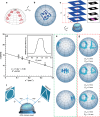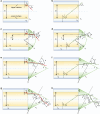Optical fibre based artificial compound eyes for direct static imaging and ultrafast motion detection
- PMID: 39294111
- PMCID: PMC11410978
- DOI: 10.1038/s41377-024-01580-5
Optical fibre based artificial compound eyes for direct static imaging and ultrafast motion detection
Abstract
Natural selection has driven arthropods to evolve fantastic natural compound eyes (NCEs) with a unique anatomical structure, providing a promising blueprint for artificial compound eyes (ACEs) to achieve static and dynamic perceptions in complex environments. Specifically, each NCE utilises an array of ommatidia, the imaging units, distributed on a curved surface to enable abundant merits. This has inspired the development of many ACEs using various microlens arrays, but the reported ACEs have limited performances in static imaging and motion detection. Particularly, it is challenging to mimic the apposition modality to effectively transmit light rays collected by many microlenses on a curved surface to a flat imaging sensor chip while preserving their spatial relationships without interference. In this study, we integrate 271 lensed polymer optical fibres into a dome-like structure to faithfully mimic the structure of NCE. Our ACE has several parameters comparable to the NCEs: 271 ommatidia versus 272 for bark beetles, and 180o field of view (FOV) versus 150-180o FOV for most arthropods. In addition, our ACE outperforms the typical NCEs by ~100 times in dynamic response: 31.3 kHz versus 205 Hz for Glossina morsitans. Compared with other reported ACEs, our ACE enables real-time, 180o panoramic direct imaging and depth estimation within its nearly infinite depth of field. Moreover, our ACE can respond to an angular motion up to 5.6×106 deg/s with the ability to identify translation and rotation, making it suitable for applications to capture high-speed objects, such as surveillance, unmanned aerial/ground vehicles, and virtual reality.
© 2024. The Author(s).
Conflict of interest statement
The authors declare no competing interests.
Figures









References
-
- Hooke, R. Micrographia, or, Some Physiological Descriptions of Minute Bodies Made by Magnifying Glasses: with Observations and Inquiries Thereupon (Jo. Martyn and Ja. Allestry, 1665).
-
- Exner, S. Die Physiologie der Facettirten Augen von Krebsen und Insecten: Eine Studie. (Franz Deuticke, Leipzig, 1891).
Grants and funding
- 15215620, N_PolyU511/20/Research Grants Council, University Grants Committee (RGC, UGC)
- ITF-MHKJFS MHP/085/22/Innovation and Technology Commission (ITF)
- 62061160488/National Natural Science Foundation of China (National Science Foundation of China)
- 52275529/National Natural Science Foundation of China (National Science Foundation of China)
LinkOut - more resources
Full Text Sources
Miscellaneous

